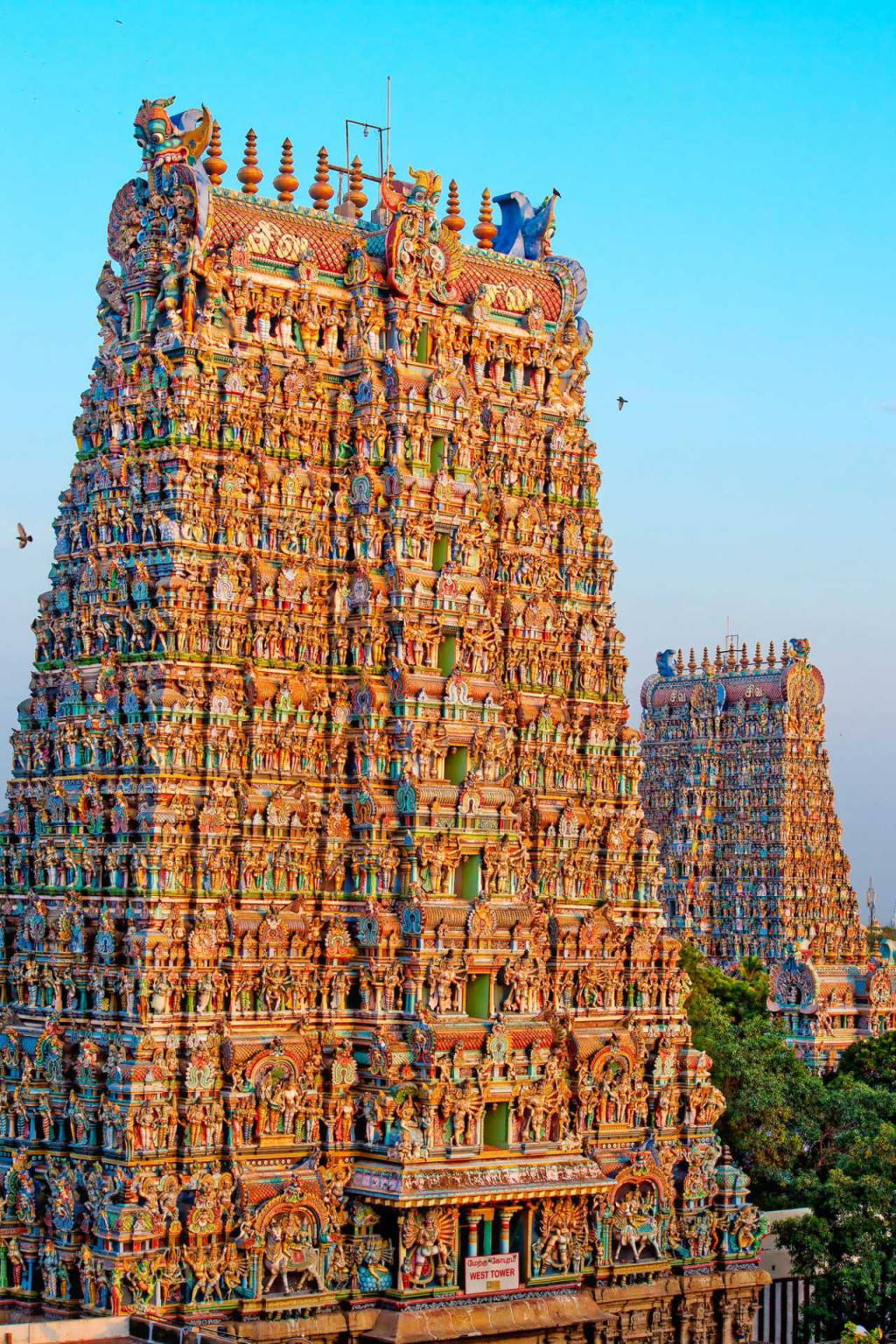
The Meenakshi Amman Temple, also known as the Minakshi-Sundareshwara Temple, is an ancient and significant temple located in Madurai, India. It holds great mythological and historical importance as it is believed that Lord Shiva took the form of Sundareswarar and married Parvati, also known as Meenakshi, at the site where the temple is currently located. The temple's architecture is renowned for its beauty and grandeur, and it was even nominated as one of the wonders of the world. Though it did not make it to the final list, it is considered one of the wonders of India and a popular attraction in South India. The temple attracts thousands of devotees every day, and during the Tirukalyanam Festival, over a million devotees come to the temple. Despite the large number of visitors, the temple is well-maintained and was even named the cleanest iconic place in India.
According to legend, Meenakshi emerged from a sacred fire as a three-year-old girl during a Yajna (sacred fire) performed by King Malayadwaja Pandya and his wife Kanchanamalai. The couple, who had no children, prayed to Lord Shiva for a son, but instead, a triple-breasted girl appeared. They were told not to worry about the girl's appearance as her third breast would disappear when she met her future husband. They named her Meenakshi and eventually crowned her as their successor. Meenakshi ruled over Madurai and even captured neighboring kingdoms. She is said to have captured Indralok, the abode of Lord Indra, and was on her way to capture Kailash, the abode of Lord Shiva, when Shiva appeared before her, and her third breast disappeared. They returned to Madurai for their wedding, which was attended by all the gods and goddesses, and is still celebrated every year as Chithirai Thiruvizha or Tirukalyanam.
The history of the temple dates back to the 1st century C.E., and it is believed that Kulashekarar Pandyan, a king who ruled over the Pandyan dynasty, built the temple based on Lord Shiva's instructions in his dream. Religious texts dating back to the 1st to 4th century C.E. describe the temple as the central structure of the city. The temple was rebuilt throughout the 16th century after being destroyed by Muslim invaders. During the 14th century, Malik Kafur, a commander of the Delhi Sultanate, looted many temples in southern India, including the Meenakshi Temple. The temple was rebuilt and expanded during the late 16th and early 17th centuries by Vishwanatha Nayakar, a king of the Nayaka dynasty, following the architectural style of Silpa Shastras. Thirumalai Nayak further expanded the temple, adding many pillared halls during his reign from 1623 to 1655. The temple was later degraded and partially destroyed during British Rule, but restoration work began in 1959 and was completed in 1995.
The temple covers a vast area of 14 acres and is surrounded by enormous walls built to protect against invasions. When viewed from above, the entire structure represents a mandala, a spiritual symbol in Hinduism. The temple's layout comprises several Gopurams, or monumental gateways, intricately carved with various gods and goddesses. The temple houses several shrines dedicated to different gods and goddesses, and its main attractions include the Golden Lotus Tank, the Meenakshi Nayak Mandapam, and the Thousand Pillar Hall.
The temple structure is also adorned with intricate carvings and sculptures. One of the most striking features of the temple is the four towering gopurams (gateway towers) that rise to a height of more than 160 feet. These towers are adorned with colorful sculptures and carvings that depict various stories from Hindu mythology. The tallest gopuram, which is located at the entrance of the temple, is called the ‘Rajaraja Gopuram’ and is one of the most impressive structures in the temple complex. The gopurams are also painted in bright colors, adding to the temple’s overall grandeur.
The temple complex is divided into two main parts, the Meenakshi shrine and the Sundareswarar shrine. The Meenakshi shrine is located in the southern part of the complex and is dedicated to Goddess Parvati in her form as Meenakshi. The shrine houses a golden idol of Meenakshi adorned with jewelry and flowers. The Sundareswarar shrine, located in the northern part of the complex, is dedicated to Lord Shiva in his form as Sundareswarar. The shrine houses a lingam (symbol of Shiva) and a statue of Nandi (Shiva’s bull mount).
Apart from these two main shrines, the temple complex also houses several smaller shrines dedicated to various deities. The complex also has several mandapams (pillared halls) where devotees can sit and meditate. The most important mandapam is the ‘Thousand Pillar Hall’ which is located in the center of the complex. As the name suggests, this hall is supported by one thousand pillars, each of which is intricately carved with various images.
Overall, the Meenakshi Temple is not just a place of worship but also a symbol of the rich cultural heritage of India. Its stunning architecture, intricate carvings, and rich history make it one of the most popular tourist destinations in South India. The temple is a must-visit for anyone interested in Hindu mythology or ancient Indian architecture.
The temple also houses a museum, where visitors can see ancient artifacts and relics related to the temple's history and mythology. The museum has a vast collection of ancient scriptures, inscriptions, and idols. There is also a library in the temple complex which has a large collection of religious books and texts.
One of the most striking features of the temple is its gopurams (ornate entrance towers), which are adorned with colorful and intricate sculptures depicting various mythological scenes. The gopurams are among the tallest temple towers in South India, with the tallest one standing at 52 meters. The gopurams are a true testimony to the skill and craftsmanship of the ancient artisans who built them.
Another important feature of the temple is the 'Golden Lotus Tank' or the 'Pottramarai Kulam.' The tank is located in the center of the temple complex and is surrounded by a pillared hall. The tank is believed to have healing powers and is used for ritual bathing and purification. The hall surrounding the tank is used for cultural events and festivals.
Overall, the Meenakshi Amman Temple is not just a religious site, but also a masterpiece of architecture, art, and history. It is a must-visit destination for anyone interested in exploring the rich cultural heritage of India.
Fast Facts
Location: Madurai, Tamil Nadu
Built By: Kulashekarar Pandyan
Architectural Style: Dravidian
Dedicated To: Meenakshi (Goddess Parvati) and Sundareswarar (Lord Shiva)
Tradition: Shaivism
Major Festival: Tirukalyanam Festival / Chithirai Thiruvizha






Comments (1)
Nice